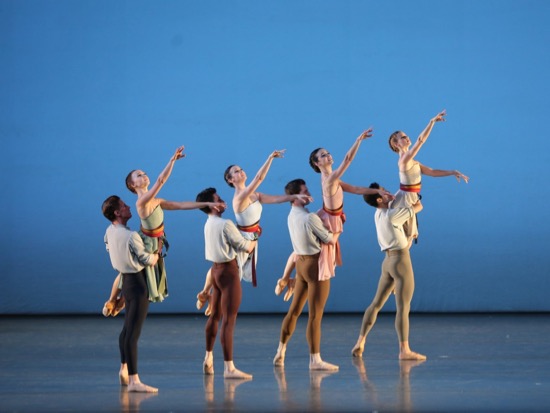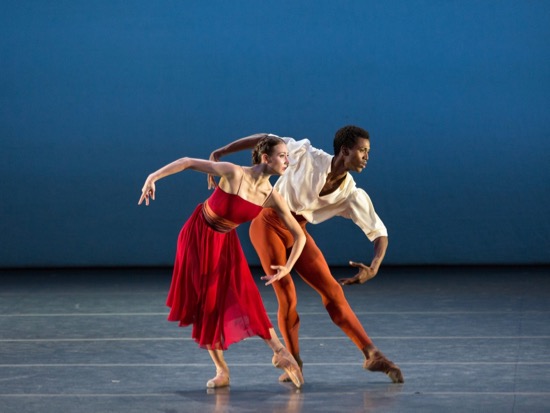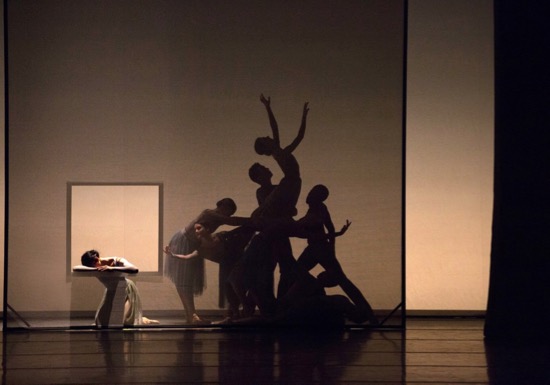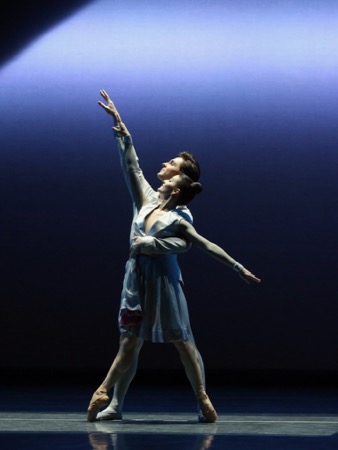ABT presents new and recent ballets at Lincoln Center through October 29th.

American Ballet Theatre dancers in Alexei Ratmansky’s Songs of Bukovina. Photo: Marty Sohl
As diverse and original as Alexei Ratmansky’s ballets are, it’s tempting to probe for artistic sources that may have nourished them. His Russian roots include his experiences as a dancer in the Kirov Ballet and as the Bolshoi Ballet’s artistic director. His years as a member of the Royal Danish Ballet count too. Few ballet choreographers create images of society in their works. Ramansky’s ballets, however “abstract” they may appear to be, link him with those choreographed by August Bournonville for the RDB in the nineteenth century, as well as those that Jerome Robbins made for the New York City Ballet and American Ballet Theatre in the twentieth.
I admit to falling in love with almost every ballet of Ratmansky’s that I’ve seen. And his new Songs of Bukovina, which premieres during American Ballet Theater’s Lincoln Center season, is no exception. Even though only ten dancers appear in it, what occurs onstage resembles a polished village festival that I wish I could attend. Leonid Desyatnikov loosely based his “Bukovinian Songs [24 Preludes for Piano]” on material he found in a collection of Ukrainian folk songs (Bukovina is a region partly in Ukraine—where the composer was born and where Ratmansky was raised— and partly in Romania). Moritz Junge has costumed the women in short, lightweight, sleeveless dresses in pale colors, but with bright sashes; the men wear tights and shirts with rolled-up sleeves.
As guest pianist Alexei Goribol begins to play excerpts from the suite, the dancers enter one or two at a time. Right away, you’re surprised. They run in and halt suddenly, their feet wide apart, almost skidding into a stop, as if they’d had to put on the brakes. They don’t so much form partners as find partners. And after pairing up and dancing in unison, the women sit on the floor briefly and put their hands beneath their chins (perhaps the ghost of a song that tells of a maiden thinking lurks in the music). If at one point, the male leader, Gabe Stone Shayer (replacing the injured Alban Lendorf), leaves the stage covering his ears with his hands, he must have his reasons. Allusions to folk dances also crop up. It’s in a circle that the men skip with macho zest while the women size them up. Later, groups enter, their arms linked in a chain.

Another cast in Songs of Bukovina: Christine Shevchenko and Calvin Royal III. Photo: Marty Sohl.
Ratmansky’s choreography is wonderfully musical as well as inventive—threading, say, soaring leaps through bouts of rapid footwork, shaping phrases of movement that are melodic and rich in terms of contrast. Usually it’s the men who fly the women into the air, but once, at least one man hoists another guy. I’m impressed by the way that unison sometimes sneaks in so that you think the dancers have made a decision to work together. The way they look at one another is integral to this; they don’t just happen to be onstage together, they’ve come here for a reason, and it’s for other reasons that they leave what Brad Fields’ lighting suggests is an outdoor space.
At the performance I saw, you could imagine Shayer and red-clad Isabella Boylston as hosting this gathering; the others bow to them and form an aisle for them to walk through. Shayer, a wonderfully nimble leaper, leads his male colleagues onstage in one sequence and performs some bunched-up, rabbity jumps before falling flat on his face for a few seconds (the others stand at the back, their legs so far apart you wonder if they’ll sink to the floor). When Boylston dances a sweet, meditative solo, those onstage back up as she nears them, wanting to give her more room. When Shayer and Boylston are left alone together, they look around as if wondering where everyone has gone.
They’re not the only ones to catch our attention. Joo Wan Ahn partners three spicy women (April Giangeruso, Katherine Williams, and Stephanie Williams) and lets them support him, until the one he’s been waiting for (Lauren Post) appears. She gets to dance a brisk solo, then Giangeruso gets a turn, then K. Williams and S. Williams celebrate together, watched by the men (Marshall Whiteley, Duncan Lyle, and Patrick Frenette join Ahn).
Classical steps almost look chosen. Shayer lifts Boylston barely off the ground several times in a row, as if he loves trying it out, just as she enjoys sitting on his shoulder. The final image of the ballet is of him helping her to stand on one leg and whip the other around as she spins. So yes, these qualify as assisted fouettés, but they’re a fine windup to the climatic move: he flings her backward over his shoulder, and the lights go out. Maybe this is a wedding party. Who can say?

A tableau near the beginning of Jessica Lang’s Her Notes. Photo: Rosalie O’Connor.
The October 20th program featured two ballets I’d seen before: Jessica Lang’s Her Notes (2016) and Christopher Wheeldon’s Thirteen Diversions (2011). This time, for various reasons, I didn’t read the program notes for Lang’s ballet before the curtain went up, whereas in October of last year, what I had read influenced how I viewed what happened onstage. Back then, I later did a little more digging and began my artsjournal.com review with this paragraph:
“The architecture for Lang’s Her Notes comes primarily from the choreographer’s set design and Nicole Pearce’s lighting, but the music (piano soloist: Emily Wong) affects it too. This ballet for ten dancers is set to five selections from Fanny Hensel’s “Das Jahr”: January, February, June, December, and a postlude. Hensel was born Fanny Mendelssohn, Felix’s older sister; a highly skilled pianist like her brother, and the composer of 460 works for piano. However, having been born a woman in the early 19th century, she was from the start made aware what kind of life she was to lead. Her father decreed her role to be that of a devoted wife and mother. She performed as a pianist in public only once, although music-lovers knew her worth from regular Sunday afternoon concerts in the Mendelssohn home. Her brother published some of her compositions for piano or piano and voice under his name.
Fortunately, her husband, a moderately successful painter (mainly portraits) made no fuss when she began toward the end of her life to publish some of her works. He illustrated and wrote poems on the varicolored pieces of paper on which she wrote the score for “Das Jahre,” the year (1846) before her sudden premature death from a stroke.”
This October, it took me a while to acclimate to the ballet—to recall that the four selections Lang chose from “Das Jahre” were subtitled (by the composer) after the months of a year that Hensel and her husband spent traveling: January, February, June, December. And it was a while before I could interpret the ingenious panels (designed by Lang herself) that, abetted by light changes, form several different settings, ranging from a “house” with a low entryway to a windowed panel that is tipped horizontally and lowered over Stella Abrera as if it were a huge skirt she is donning.
There are ten excellent dancers in this intriguing ballet too, and, as the sweet or vigorous piano music spools out, you can imagine them as Fanny, her husband, and their family and friends. Sarah Lane and Arron Scott lead the February section, spurred on by Skylar Brandt, Cassandra Trenary, Alexandre Hammoudi, and Calvin Royal III, and the scene is lively and changeable. The same two men appear with Christine Shevchenko and K. Williams in “June,” but this adagio section is dominated by a curious duet between Abrera and the ardent James Whitener. Perhaps the several times she lies on the floor refer to Fanny’s early death; he picks her up, swings her into the air; why does he then put her down again? And pick her up in another way? And once more lay her out? Once the men too lie down, as if they are imagining dying.
When all the cast members are dancing together (“December”), Shevchenko and Williams remain close together in one corner, moving quietly like friends conversing. In the end, the scenery, which has risen earlier, descends and, helped by the two women, again imprisons Abrera in its window. This time, they lift it again. Freeing her soul, perhaps, or the soul of Fanny Mendelssohn Hensel’s music. Possibilities such as these, beautifully and expressively defined, are nevertheless slightly irritating. Where are we now, and what’s going on among the people in this society? Lang’s intriguing ballet touches obliquely on love, death, music, restrictions that confine women, and new horizons, yet remains enigmatic.

Sarah Lane and Joseph Gorak in Christopher Wheeldon’s Thirteen Diversions. Photo: Marty Sohl.
Wheeldon’s Thirteen Diversions is the “big” ballet that ends the evening. Big in terms of its music: Benjamin Britten’s “Diversions for Piano (left hand) and Orchestra.” Big in terms of its cast: four principal couples in white and eight men and eight women in black (costumes by Bob Crowley) Barbara Bilach is the piano soloist and Charles Barker conducts the orchestra.
If you glance at the program, you might feel faint. A theme, eleven variations, and a tarantella as a finale: the list rolls down the page (what if, about to see The Sleeping Beauty, you learned that not six fairies but twelve were going to gift the royal infant with solos?). But Wheeldon slips his variations so silkily around one another that you never get the feeling of a list and become happy to see so many fine dancers executing such intrepid choreography. Looking back again, this time at my 2011 review, I find this sentence relevant: “Wheeldon provides strictly classical steps, sometimes eased around the seams. For instance, executing pirouette after pirouette while travelling, the dancers end each turn by whipping their bodies off the usual verticality as they begin the plunge into the next spin.” Six years later, one of my scribbled notes says “feelingful torso” (“feelingful” is a word I don’t usually stoop to in public, but it’ll do as a reminder).
Lighting designer Fields’ contribution is a vital part of the piece, beginning with the image of a curtain at the rear of the stage being drawn back on one side to reveal a glowing triangle of light with a narrow beam slicing across it. This is the world into which the dancers rush and continue departing and returning in new combinations, while Britten’s variations dart among “March,” “Chorale,” “Nocturne” et al.
At the performance I attended, the principal pairs were Sarah Lane and Joseph Gorak, Hee Seo and Cory Stearns, Gillian Murphy and Blaine Hoven, Skylar Brandt and Zhiyao Zhang. As in all the ballets on the program, these splendid foregrounded dancers are a mix of principals, soloists, and corps de ballet members. It is a tribute to ABT and its artistic director Kevin McKenzie that you’d be hard put to pick out who belonged to which rank.
We watch them as they show us vivacious speed or romantic slowness, as they twine together or lift each other in surprising ways, while their black-clad associates shadow them or shape the intricacies of Wheeldon’s patterns on their own. The evening has gotten more formal as it progressed, but formality in this case doesn’t involve coldness. These are ballets with beating hearts.

Lovely, thank you, once again for putting me in the theater with you, especially for the Ratmansky.